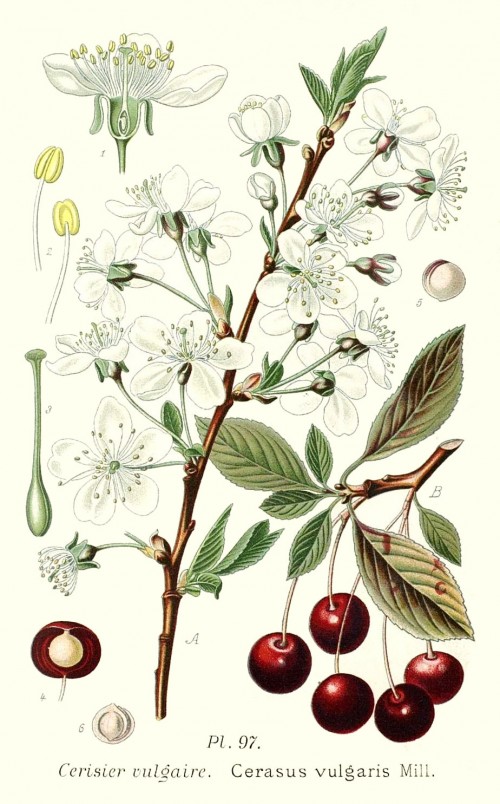Dies ist eine alte Version des Dokuments!
Rosaceae - sy. Cerasus vulgaris Mill.; sour cherry, Sauerkirsche
„Prunus cerasus is thought to have originated as a natural hybrid between Prunus avium and Prunus fruticosa in the Iranian Plateau or Eastern Europe where the two species come into contact. Prunus fruticosa is believed to have provided its smaller size and sour tasting fruit. The hybrids then stabilised and interbred to form a new, distinct species.“ http://en.wikipedia.org/wiki/Prunus_cerasus
„Freshly squeezed cherry juice was dominated by green-grassy fragrance notes. After 15 minutes, the typical cherry aroma appeared with the features bitter almond-like, fruity, green and spicy. After another 20 minutes, a „cucumber-like“ odor note increasingly emerged. By heat treatment, for example, during simultaneous distillation / extraction, cherry flavor was stabilized.
… The flavour compounds were isolated from cherry juice by simultaneous distillation/extraction (extract I) and also by vacuum distillation followed by extraction of the condensate (extract II)… Sniffing the stepwise diluted extracts I and II revealed the same seven compounds with the highest aroma values: benzaldehyde, linalool, hexanal, 2(E)-hexenal, phenylacetaldehyde, 2(E),6(Z)-nonadienal and eugenol. Extract I contained in addition a flavour compound of high aroma value, whose structure is unknown.“
[Identifizierung flüchtiger Aromastoffe mit hohen Aromawerten in Sauerkirschen (Prunus cerasus L.), Wolfgang Schmid, Werner Grosch, Zeitschrift für Lebensmittel-Untersuchung und -Forschung 01/1986; 182(5):407-412]
„The analysis results for seven of the aroma compounds obtained by vacuum distillation from sweet and sour cherry products were compared. The freshly pressed juices from 5 varieties of sour and 5 varieties of sweet cherries showed great differences in concentrations (μg/1): benzaldehyde (18–393), linalool (0.5–1.7), hexanal (0.3–54.7), 2(E)-hexenal (2.4–220), 2(E),6(Z)-nonadienal (0.1–2.4), phenylacetaldehyde (2.1–5.6) and eugenol (1.0–22.2). The benzaldehyde content of the juices showed the highest correlation to the recognition threshold of the cherry aroma note. The cherry jam showed a drastic change in the aroma composition: benzaldehyde and linalool increased greatly (7 and 13-times, respectively), while hexanal, 2(E)-hexenal and phenylacetaldehyde strongly decreased. The increase in benzaldehyde and linalool, which was also observed during simultaneous distillation/extraction of the juices, is caused by the hydrolysis of the corresponding glycosides during the heat treatments.“
[Quantitative analyse flüchtiger Aromastoffe mit hohen Aromawerten in Sauerkirschen (Prunus cerasus L.), Süßkirschen (Prunus avium L.) und Kirschkonfitüren., Schmid, W., Grosch, W., Zeitschrift für Lebensmittel-Untersuchung und Forschung, Vol.183(1), 1986, 39-44]

Masclef,A., Atlas des plantes de France, vol.2 t.97 (1890)
http://plantgenera.org/species.php?id_species=1265267
